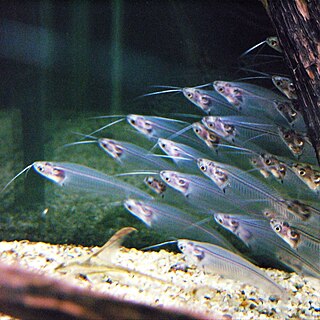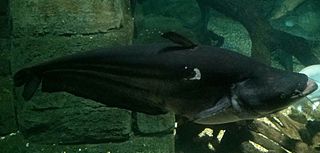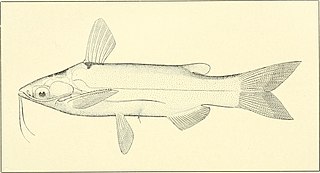
The Ictaluridae, sometimes called ictalurids, are a family of catfish native to North America, where they are an important food source and sometimes fished for sport. The family includes about 51 species, some commonly known as bullheads, madtoms, channel catfish, and blue catfish.

Hypostomus is a genus of catfish in the family Loricariidae. They are native to tropical and subtropical South America. H. plecostomus is the popular freshwater aquarium fish formerly known as Plecostomus plecostomus. The taxonomic structure of the Loricariidae is still being expanded by scientists. Hypostomus is a highly species-rich and widely distributed catfish genus.

The Amblycipitidae are a family of catfishes, commonly known as torrent catfishes. It includes three genera, Amblyceps, Liobagrus, and Xiurenbagrus, and about 36 species.

The Pimelodidae, commonly known as the long-whiskered catfishes, are a family of catfishes.

Wallago attu, the Sareng catfish is a freshwater catfish of the family Siluridae, native to South and Southeast Asia. W. attu is found in large rivers and lakes in two geographically disconnected regions, with one population living over much of the Indian Subcontinent and the other in parts of Southeast Asia. This species can reach a length up to 1.1 m.

Sisoridae is a family of catfishes. These Asian catfishes live in fast-moving waters and often have adaptations that allow them to adhere to objects in their habitats. The family includes about 235 species.

Siluridae is the nominate family of catfishes in the order Siluriformes. About 105 living species of silurids are placed in 12 or 14 genera.

Kryptopterus is a genus of catfishes belonging to the family Siluridae. They are found in freshwater throughout Southeast Asia. The scientific name comes from Ancient Greek kryptós + ptéryx. It refers to the reduced or even entirely absent dorsal fin of these catfishes.

Kryptopterus cryptopterus is a species of catfish, the type species of the genus Kryptopterus. It can be distinguished from all its congeners, with the exception of the newly split Kryptopterus geminus, by the almost flat dorsal profile with no concavity behind the head. This species grows to a length of 14.6 centimetres (5.7 in) SL.
Kryptopterus geminus is a species of catfish belonging to the family Siluridae. It can be distinguished from all its congeners, with the exception of Kryptopterus cryptopterus, by the almost flat dorsal profile with no concavity behind the head. This species grows to a length of 17.1 centimetres (6.7 in) SL.

Wallagonia micropogon is a species of catfish in the genus Wallagonia. This species was recently discovered and is found in the Mekong River drainage area between southern Vietnam and northern Laos as well as Chao Phraya River in Thailand. It is a freshwater fish.

Hemibagrus is a genus of catfishes of the family Bagridae.

Bagarius is an Asian genus of catfishes of the family Sisoridae. It includes five to six extant species and potentially one extinct fossil species, B. gigas.

Schilbe is a genus of schilbid catfishes native to Africa. Some are colloquially called butter catfish, though this may also refer to the Asian genus Ompok of the family Siluridae.
Ompok is a genus of fish in the family Siluridae found in lakes and large rivers throughout South and Southeast Asia.

Entomocorus benjamini is a species of driftwood catfish found in the Madeira River system in Bolivia and Brazil. This species grows to a length of 7.0 cm and can be distinguished from it congeners in that the distal half of dorsal caudal fin lobe and the edge of the ventral lobe is pigmented.
Wallagonia maculatus is a species of catfish in the family Siluridae endemic to Malaysia, where it is known only from Sabah in northern Borneo. This species grows up to a length of 100 centimetres (39 in) SL.

Wallagonia leerii, also known as the Tapah, helicopter catfish, and formerly the striped wallago catfish is a species of catfish native to Southeast Asia. Its habitat ranges from the river drainages of Thailand through the Malayan peninsula to the islands of Sumatra and Borneo in Indonesia. It can grow up to 2 m in length and weigh up to 150 kg (330 lb). It has been used as food in Southeast Asia since ancient times. Overfishing for its prized meat has caused the population to significantly decrease. Furthermore, the breeding migration pattern of this fish is especially vulnerable to damming, which has also decreased the wild population significantly.

Wallagonia is a recently established genus of silurid catfishes, containing 3 distinct species, all of whom are native to Southeast Asia:















